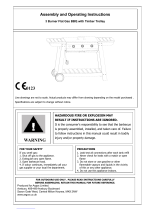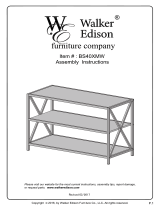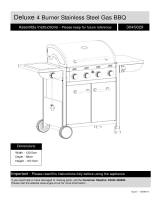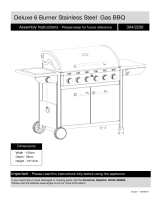
Excel 100
Excel 300 Excel 200
0694BR0014
Assembly and Operating Instructions for
Excel 100, Excel 200, and Excel 300 Gas Barbecues
Gas Barbecues
Photographs are not to scale.
Specifications subject to change
without prior notice.
WARNING
• For outdoor use only. Not for commercial use.
• Read instructions before using the appliance. Failure to follow instructions could
result in death, serious bodily injury, and/or property loss.
• Warning: accessible parts may be very hot. Keep young children away.
• Do not move the appliance during use.
• Turn off the gas supply at the gas bottle after use.
• Any modification of the appliance, misuse, or failure to follow the instructions may
be dangerous and will invalidate your warranty. This does not affect your statutory
rights.
• Retain these instructions for future reference.
• Leak test your barbecue annually. Check the hose connections are tight and leak
test them each time you reconnect the gas bottle.
FOR YOUR SAFETY
If you smell gas:
1. Shut off gas to the appliance.
2. Extinguish any open flame.
3. Open barbecue lid or hood.
4. If odour continues, discontinue use and
contact your local dealer.
FOR YOUR SAFETY
1. Do not store or use petrol or other flammable
vapours or liquids in the vicinity of this or any
other appliance.
2. A gas bottle not connected for use shall not be
stored in the vicinity of this or any other
appliance.

2
A. Parts List
Quantities vary according to model purchased. Specifications subject to change without prior notice. For more
details on hardware, please see the corresponding Hardware Reference Diagram for your barbecue model.
OUTBACK® EXCEL RANGE
CODE PART QTY EXCEL 100 EXCEL 200 EXEL 300
Body
Assembly
A1 Lava Rock Rack 1
√ √ √
A2 Burner 1
√ √ √
A3 Hood Lower Handle 1
√ √ √
A4 Hood 1
√* √* √*
A5 Body 1
√* √* √*
A6 Grease Cup Holder 1
√ √ √
A7 Grease Cup 1
√ √ √
A8 Cooking Grill 1
√ √ √
A9 Lava Rock (Shrink Packed) 1
√* √* √*
A10 Hood Upper Handle 1
√* √* √*
A11 Hinge Bracket 2
√* √* √*
A12 Main Electrode & Gas Collector Box 1
√ √ √
A13 Heat Shield 1
√ √ √
A14 Warming Rack 1
√ √ √
Upper
Trolle y
B1 Contro l Pane l 1
√ √ √
B2 Igniter Button 1
√* √* √*
B3 Main Burner Knob 2
√* √* √*
B4 Trolle y Handle 1
√
B5 Main Burner Hose 1
√* √* √*
B6 Side Shelf ▲ 2 1
B7 Side Burner Knob 1
√
B8 Side Burner Rack 1
√
B9 Side Burner Shelf 1
√
B10 Side Burner 1
√
B11 Side Burner Electrode 1
√
B12 Side Burner Valve/Hose Assembly 1
√*
Lower
Trolle y
C1 Short Leg Front 1
√ √ √
C3 Gas Cylinder Holder 1
√ √ √
C4 Wheel 2
√ √ √
C5 Axle 1
√ √ √
C6 Leg End Loop 1
√ √ √
C7 Long Leg Front 1
√ √ √
C10 Gas Bottle Strap 1
√* √* √*
Hardware
D1 M6x15 Bolt ▲ 24 28 28
D2 M5x10 Bolt 4
√ √ √
D3 M4x10 Bolt 1
√
D4 ST4.0x10 Screw 2
√ √ √
D5 ST4.8x15 Screw 2
√ √ √
D6 M8 Locknut 2
√ √ √
D7 M5 Keps Nut 2
√ √ √
D8 Wheel Spacer 2
√ √ √
D9 Shelf Spacer ▲ 8 4
C2 Short Leg Rear 1
√ √ √
C8 Long Leg Rear 1
√ √ √
C9 Bottom Shelf 1
√ √ √
A16 Body Support 2
√ √ √
A15 Sillcon Bumpers 2
√ √ √
Pre-Assembled
Quantity and specification varies according to model purchased.

3
B1. Parts Diagram: Excel 100
Quantities vary according to model purchased. Specifications subject to change without prior notice. For more
details on hardware, please see ‘Hardware Reference Diagram: Excel 100.’
A8
A1
A9
A2
A13
A6
A7
A12
A3
A14
B1
B2
B3
B4
B5
C1
C3
C4
C6
C7
C9
C5
C2
C8
C10
A4 A5 A10
A11 A15
Pre-assembled body unit
includes the follo wing
individual parts:
A16

4
B2. Hardware Reference Diagram: Excel 100
Specifications subject to change without prior notice.
D1
D1 D4 D2
D5 D6 D7

5
C1. Parts Diagram: Excel 200
Quantities vary according to model purchased. Specifications subject to change without prior notice. For more
details on hardware, please see ‘Hardware Reference Diagram: Excel 200.’
A8
A1
A9
A6
A7
A3
A2
A13
A12
A14
B1
B2
B3
B5
B6
C1
C3
C4
C6
C7
C9
C5
C2
C8
C10
Pre-assembled body unit
includes the follo wing
individual parts:
A4 A5 A10
A11 A15
A16

6
C2. Hardware Reference Diagram: Excel 200
Specifications subject to change without prior notice.
D1
D4
D2 D5
D6
D9
D7
D1

7
D1. Parts Diagram: Excel 300
Quantities vary according to model purchased. Specifications subject to change without prior notice. For more
details on hardware, please see ‘Hardware Reference Diagram: Excel 300.’
A8
A1
A9
A2
A13
A6
A12
A3
A14
B1
B2
B3
B5
B8
B11
B10
B9
B7
B6
A7
C1
C3
C4
C6
C7
C9
C5
C2
C8
C10
Pre-assembled body unit
includes the follo wing
individual parts:
A4 A5 A10
A11 A15
B12
A16

8
D2. Hardware Reference Diagram: Excel 300
Specifications subject to change without prior notice.
D1
D1 D5
D4 D3
D7
D9 D2 D6

9
E. Assembly
TOOLS NEEDED FOR ASSEMBLY:
Medium size flat blade or Philips/cross-point screwdriver, adjustable spanner or metric spanner set
This barbecue requires two people for assembly. Please remove all packaging materials from all
individual parts before assembling. Please lay out all nuts and bolts and check lengths before
assembling. Whilst every care is taken during the manufacture of this product, care must be taken
during the assembly in case sharp edges are present.
2
Excel 100 Excel 200 Excel 300
C6
C7
Attach the Long Leg
Front (C7) and Long
Leg Rear (C8) to the
Leg End Loop (C6).
The legs are a push fit
onto the Leg End Loop.
In case of difficulty, they
may need tapping with
a soft faced mallet.
Take care not to
damage the parts.
C1
C2
C3
Attach the Short Leg
Front (C1) and Short
Leg Rear (C2) to the
Gas Cylinder Holder
(C3). The legs are a
push fit onto the Gas
Cylinder Holder. In case
of difficulty; they may
need tapping with a soft
faced mallet. Take care
not to damage the
parts.
Excel 100 Excel 200 Excel 300
1

10
Attach the Bottom Shelf (C9) to the Gas Bottle
Holder (C3) using the screws (D5). Taking care
not to over tighten.
C9
C3
D1
Attach the leg assembly to the
Bottom Shelf assembly using the
screws (D1).
4
3
Excel 100 Excel 200 Excel 300
Excel 100 Excel 200 Excel 300
D5

11
C4
Slide a wheel (C4) and secure it
with a M8 Locknut (D6). Repeat for
the other side before standing it up.
C5
D8
Insert the axle (C5) through the clamping
brackets underneath the Gas Cylinder Holder
(C3) and tighten the clamping screws. Taking
care not to over tighten.
Slide a Wheel Spacer (D8) over the Axle (C5).
C3
6
5
Excel 100 Excel 200 Excel 300
Excel 100 Excel 200 Excel 300
D6
D1
A16
Attach the Body Support (A16) to the
legs using the screws (D1).
Note: The securing tabs on the end of
the supports should face away from the
barbecue as shown in the diagram.

12
A3
A4
D2
D1
Attach the Hood Lower Handle (A3) to the Hood
(A4) using the Screws (D2).
Attach the body (A5) to the Trolley
Assembly by sliding the fixing brackets
inside the tops of the legs and securing
with the screws (D1).
A5
8
7
Excel 100 Excel 200 Excel 300
Excel 100 Excel 200 Excel 300

13
A6
A7
Feed the Grease Cup Holder (A6)
through the hole in the Body (A5).
Insert the Grease Cup (A7) into the
Grease Cup Holder.
10
9
Excel 100 Excel 200 Excel 300
Excel 100 Excel 200 Excel 300
Attach the Control Panel Assembly to the Trolley Assembly using the Screws (D1).

14
Fit the Burner (A2) into the Body (A5)
ensuring the burner venturi tubes are over
the ends of the gas valves. They are a loose
fit and not a gas tight seal. Secure the
Burner with the Screws (D4);
A2
View looking underneath the body.
12
11
Excel 100 Excel 200 Excel 300
Excel 100 Excel 200 Excel 300
Remove the lower nut from the main electrode (A12) and insert the electrode with
the gas collector box into the hole in the bottom of the body. The open face of the
gas collector box must face towards the back of the barbecue body. Secure with
the nut removed earlier.
D4

15
A13
A1
A9
A8
A14
Attach the Heat Shield (A13) to the Body (A5)
using the Screws (D2) and nuts (D7).
Place the Lava Rock Rack (A1) and Lava
Rock (A9) into the body of the barbecue
followed by the Cooking Grill (A8). Fit the
Warming rack (A14). Make sure the
swing legs fix to the body of the barbecue
and the shorter, fixed legs go through the
holes in the hood.
14
13
Excel 100 Excel 200 Excel 300
Excel 100 Excel 200 Excel 300

16
Excel 100 Excel 200 Excel 300
Excel 100 Excel 200 Excel 300
B4
D1
B6
D1
D9
Attach the Trolley Handle (B4) to the
Long Legs using the screws (D1).
Attach a side shelf (B6) to the right hand side of the barbecue by sliding a shelf spacer
(D9) onto a screw (D1) and fit the shelf to the lower fixing point on the rear leg as shown.
Repeat for the front leg. Slide a shelf spacer (D9) onto a screw (D1) and screw it into the
upper fixing point on the rear legs as shown. Repeat for the front leg. For Excel 200 only,
repeat the above procedure for the left hand side shelf.
16
15

17
Excel 100 Excel 200 Excel 300
Excel 100 Excel 200 Excel 300
D1
B9
B12
B7
Attach the Side Burner Shelf (B9) to the Short Legs using the Screws (D1).
Remove the screws from Side Burner
Valve/Hose Assembly (B12) and
secure it to the side shelf with those 2
screws;
Assemble the Side Burner Knob (B7)
onto the side burner valve.
18
17

18
ASSEMBLY IS NOW COMPLETE.
Proceed to the next page for operation and maintenance.
Important – the barbecue must not be used before being leak tested as detailed on P. 20
Excel 100 Excel 200 Excel 300
Excel 100 Excel 200 Excel 300
B11
D3
B8
Place the Side Burner Electrode (B11) onto
the side burner shelf as shown and place the
Side Burner (B10) through the central hole
and position the side burner venturi tube over
the side burner gas valve. Secure the
electrode and burner with Screw (D3).
Note: The side burner venturi tube is a loose
fit on the vale and not a gas tight seal.
Connect the electrode
wire to the Igniter
Button (B2) under the
control panel.
B2
Side burner electrode
wire goes here.
Main burner
electrode wire
goes here.
20
19
Place the Side Burner Grid (B8) onto
the side burner shelf.

19
F. Important Information
Please read these instructions carefully
before assembly and use.
• Retain these instructions for future
reference.
• For outdoors use only – do not use
indoors. Do not use below ground level.
• For use with LPG bottled gas only. A
fixed pressure regulator of 28-30mbar
must be used for butane or 37mbar for
propane.
• Remove lava rock from plastic shrink
pack before lighting.
• Do not use within 1m of any flammable
structure or surface.
• LP gas cylinders should not be placed
directly underneath the barbecue.
• LP gas cylinders must not be stored or
used in the horizontal position. A leak
would be very serious and liquid could
enter the gas line.
• When igniting barbecue open its hood
before lighting.
• Do not move the barbecue while alight.
• This barbecue must not be left
unattended when lit.
• The hood handle can become very hot.
Grip only the centre of the handle. Use of
a cooking glove is advised.
• Use caution when opening the hood, as
hot steam inside is released upon
opening.
• Parts of this barbecue become very hot –
care must be taken when children, elderly
people, and animals are present.
• Always turn off the gas bottle when the
barbecue is not in use.
• Never cover a barbecue until it has
completely cooled.
• Never use the barbecue with the side
shelf in the down position.
• Leak test annually, and whenever the gas
bottle is removed or replaced.
• Do not store flammable materials near
this barbecue.
• Do not use aerosols near this barbecue.
• Failure to follow the manual’s instructions
could result in serious injury or damage.
• If you have any queries regarding these
instructions, contact your local dealer.
G. Gas and Regulator
This barbecue can use either propane or
butane LPG bottled gas. Propane bottles,
normally red coloured, will supply gas all year
round, even on cold winter days. A spanner
may be required to change gas bottles. Butane
bottles, normally blue, will supply sufficient gas
in summer, but performance of the barbecue
may be affected once the gas temperature
starts to fall below +10°C. The bottle should
never be stood on the trolley base and placed
directly under the barbecue. Gas bottles should
never be stored or used laid on their side.
Never store gas bottles indoors.
For optimal performance, we suggest the
following:
Suitable regulators for butane must have an
outlet pressure of 28-30mbar. For propane, the
regulator must have an outlet pressure of
37mbar. YOU MUST HAVE THE PROPER
REGULATOR AND BOTTLE IN ORDER FOR
THE BARBECUE TO OPERATE SAFELY AND
EFFICIENTLY. USE OF AN INCORRECT OR
FAULTY REGULATOR IS DANGEROUS AND
WILL INVALIDATE ANY WARRANTY. Please
consult your local gas dealer for the most
suitable gas bottles and regulators.
H. Installation
H1. Selecting a Location
This barbecue is for outdoor use only and
should be placed in a well-ventilated area. Take
care to ensure that it is not placed UNDER any
combustible surface. The sides of the barbecue
should NEVER be closer than 1 metre from any
combustible surface. Keep this barbecue away
from any flammable materials!
H2. Precautions
Do not obstruct any ventilation openings in the
barbecue body. Secure the gas bottle on the
cylinder holder and always tighten it with the
black strap provided. Should you need to
Model Butane Minimum
Bottle Size
Propane Minimum
Bottle Size
Outback®
Excel 100
6kg 3.9kg
Outback®
Excel 200
6kg 3.9kg
Outback®
Excel 300
15kg 6kg

20
change the gas bottle, confirm that the
barbecue is switched off, and that there are no
sources of ignition (cigarettes, open flame,
sparks, etc.) near before proceeding. Inspect
the gas hose to ensure it is free of any twisting
or tension. The hose should hang freely with no
bends, folds, or kinks that could obstruct free
flow of gas. Apart from the connection point, no
part of the hose should touch any hot barbecue
parts. Always inspect the hose for cuts, cracks,
or excessive wear before use. If the hose is
damaged, it must be replaced with hose
suitable for use with LPG and meet the national
standards for the country of use. The length of
the hose shall not exceed 1.5m. N.B.-The date
on U.K. orange hose is the date of
manufacture, not the expiry date.
H3. Fixing the Regulator to the Gas Bottle
Confirm all barbecue control knobs are in the
off position. Connect the regulator to the gas
bottle according to your regulator and bottle
dealer’s instructions.
H4. Leak Testing (To be performed in a
well-ventilated area.)
Confirm all control knobs are in the off position.
Open the gas control valve on the bottle or
regulator. Check for leaks by brushing a
solution of ½ water and ½ soap over all gas
system joints, including all valve connections,
hose connections and regulator connections.
NEVER USE AN OPEN FLAME to test for
leaks at anytime. If bubbles form over any of
the joints, there is a leak. Turn off the gas
supply and retighten all joints. Repeat test. If
bubbles form again, do not use the barbecue.
Please contact your local dealer for assistance.
Leak test your barbecue annually. Check the
hose connections are tight and leak test them
each time you reconnect the gas bottle.
I. Operation
I1. Warning
• Before proceeding, make certain that you
understand the IMPORTANT
INFORMATION section of this manual.
I2. Preparation Before Cooking
To prevent foods from sticking to the cooking
grill, please use a long handled brush to apply
a light coat of cooking or vegetable oil before
each barbecuing session. (Note: When
cooking for the first time, paint colours may
change slightly as a result. This is normal
and should be expected.)
I3. Lighting the Barbecue
• Open the barbecue hood.
• Ensure all knobs are in the off position.
Open the gas control valve on the gas
bottle or regulator.
• Push and turn the leftmost control knob to
the high position. Press the ignition button
rapidly several times until left portion of the
burner is lit. If burner fails to ignite, turn
control knob to the off position and turn
gas off at the bottle or regulator. Wait five
minutes, then repeat the above steps.
After successful lighting of the left side,
ignite the remaining portion of the burner.
If the burner fails to ignite after following
above procedure, turn all the knobs to the
off position. Close the gas valve on the gas
bottle. Wait 5 minutes, then repeat the
above steps. If the barbecue still fails to
light, please refer to the manual ignition
instructions in section below.
• After ignition, the burner should be burned
at the high position for 3-5 minutes in order
to preheat the barbecue. This process
should be done before every cooking
session. The hood (where applicable)
should be open during preheating.
• After completion of preheating, the burner
should normally be turned down to a lower
position for best cooking results.
I4. Manual Lighting Instructions
• Insert lit match through the match-lighting
hole underneath the barbecue.
• Push and turn the rightmost control knob
anti-clockwise to the high position.
• After the right portion of the burner is lit,
light the remaining portion of the burner.
• If burner fails to ignite, contact your local
dealer for assistance.
• After ignition, the burner should be burned
at the high position for 3-5 minutes in order
to preheat the barbecue. This process
should be done before every cooking
session. The hood (where applicable)
should be open during preheating.
• After completion of preheating, the burner
should normally be turned down to a lower
position for best cooking results.
I5. Warming Rack
Warming racks are a convenient way to keep
cooked food warm or to warm items such as
bread rolls. Care should be taken to ensure
that any items placed on the warming rack are
cooked through and do not continue to cook
and drip fat or meat juices, which could drip
Page is loading ...
Page is loading ...
Page is loading ...
Page is loading ...
-
 1
1
-
 2
2
-
 3
3
-
 4
4
-
 5
5
-
 6
6
-
 7
7
-
 8
8
-
 9
9
-
 10
10
-
 11
11
-
 12
12
-
 13
13
-
 14
14
-
 15
15
-
 16
16
-
 17
17
-
 18
18
-
 19
19
-
 20
20
-
 21
21
-
 22
22
-
 23
23
-
 24
24
Outback Power Systems EXCEL 300 User manual
- Category
- Barbecues & grills
- Type
- User manual
Ask a question and I''ll find the answer in the document
Finding information in a document is now easier with AI
Other documents
-
ROOMS TO GO 26040977 Assembly Instructions
-
 Argos 84840 Assembly And Operating Instructions Manual
Argos 84840 Assembly And Operating Instructions Manual
-
Buffalo GL179 User manual
-
 Walker Edison Furniture Company HDS40XMWAG Operating instructions
Walker Edison Furniture Company HDS40XMWAG Operating instructions
-
Outback Sapphire User manual
-
Char-Broil Patio Bistro 15601632 User manual
-
 Deluxe 6 Burner Gas BBQ User manual
Deluxe 6 Burner Gas BBQ User manual
-
 Deluxe 6 Burner Gas BBQ User manual
Deluxe 6 Burner Gas BBQ User manual
-
Charbroil 4617164 Owner's manual
-
Gasmate GM172-071 Instructions Manual



























